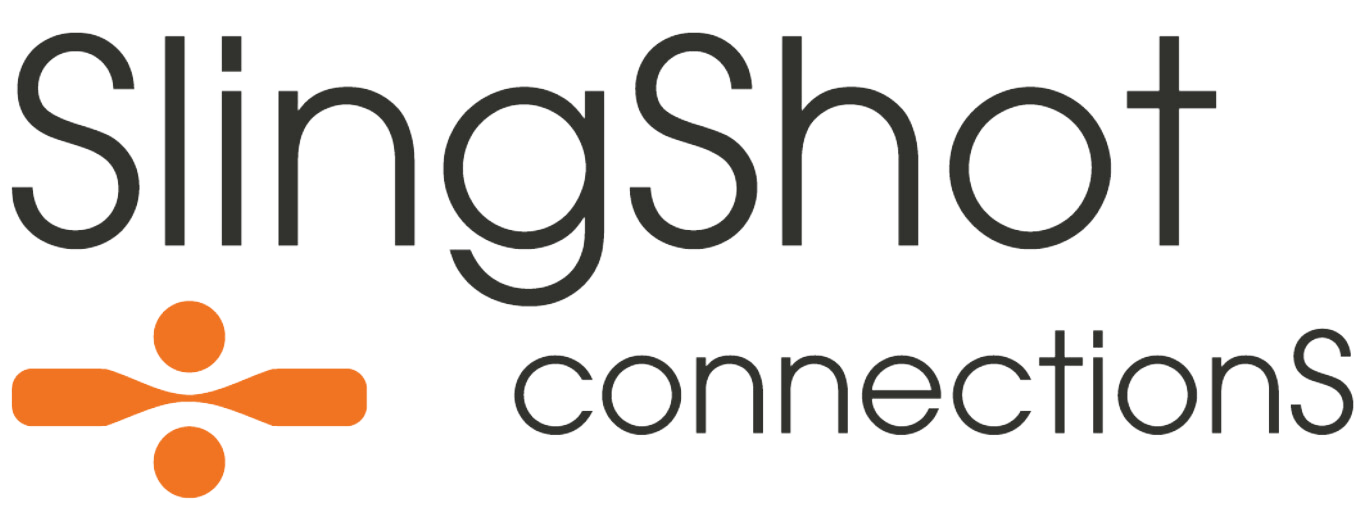The $8.5 Trillion Dollar Talent Shortage: What You Can Do to Overcome It.
By far, one of the biggest questions we hear from employers is how to deal with a lack of available talent. You’ve probably seen the effects yourself. Job vacancies lasting months, multiple rounds of interviews that go nowhere, or even receiving applicants but not having anyone qualified. According to ManPowerGroup, 75% of companies have reported difficulty recruiting qualified talent, a 17-year high. An even scarier stat; according to Kornferry, the talent shortage could lead to 8.5 trillion dollars in unrealized annual revenues by 2030.
The good news is there are ways to overcome it. Some that companies have already started to implement. But before you start implementing, it’s important to know what exactly the talent shortage is, and what’s causing it.
Table of Contents
Unraveling the shortage puzzle
What is a talent shortage?
Simply put, a talent shortage is the gap between the availability of workers and the availability of open positions. When there aren’t enough qualified workers, companies have a hard time filling positions and running efficiently.
Does this have anything to do with the skills shortage?
The skills shortage and the talent shortage go hand in hand. Traditionally, the skill shortage refers to a shortage of skilled workers in specific industries. While a talent shortage is more broad and includes the entire workforce as a whole.
But a lot of times, a skills shortage in one industry can snowball into a talent shortage. For example, in the tech industry, intense competition for IT talent can limit the pool of available candidates for non-tech sectors like finance and healthcare, which also rely on IT expertise to build technology infrastructure. This creates a talent shortage of qualified IT professionals across multiple industries.
Who will this shortage affect the most?
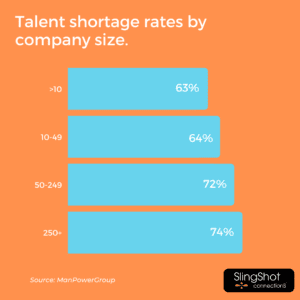
Companies with 250+ employees are facing the worst of the talent shortage at a 74% talent shortage rate. But smaller companies aren’t safe either. Companies with less than 50 employees are seeing talent shortage rates of around 64%.
In terms of roles, these are the roles that are most affected by a talent shortage:
- Operations/Logistics
- Manufacturing/Production
- Front Office/Customer Facing
- Administration/Office Support
- Sales/Marketing
It’s no coincidence that all these industries require someone to have both technical and soft skills to be effective. It’s becoming harder to find people that encompass both these types of skills.
What’s causing the talent shortage?
First things first, it’s important to clear up any misconceptions. The big one is the COVID-19 pandemic and its disruption to the job market. The COVID-19 pandemic did not start the talent shortage. It, without a doubt, disrupted the American labor force, but the origins of the talent shortage go back to before 2020. Blaming it on COVID-19 diminishes how serious the problem is. It’s here to stay. And it’s going to take a collective effort to solve it.
Instead, the underlying causes have been quietly at work, slowly building up over the decades. Here are some of the main components that make up the talent and skills shortage:
A shift in demographics
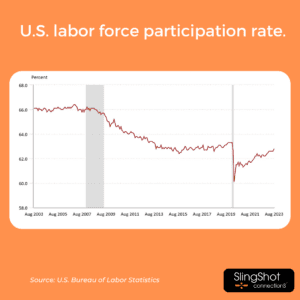
The population has been in decline to levels never seen before. According to the U.S. Census and Bureau of Labor Statistics, the U.S. labor participation rate shrank from 2010-2020. This is especially true in age groups 16-24 (the entry-level age group) and 45-54 (the leadership age group).
One cause is the amount of baby boomers that are retiring. Most are set to retire by 2030 and it’s leaving unfilled gaps in senior roles.
The population has also been on a steady decline since the 90s. Meaning we’re starting to see the early effects of a smaller workforce. Researchers expect an 85 million shortage by 2030 and for shortages to persist well into the late 2030s.
Technology has changed what skills are expected (Skills Gap)
Technology is evolving at a faster rate than ever and it’s caused a lot of confusion about what skills are needed in the workforce. According to a report by the World Economic Forum, half of all workers will need reskilling by 2025 to keep up with technological advancements.
The World Economic Forum put together a list of skills that workers should possess by 2025 to fill the skills gap. Note that the top 5 are all soft skills that have nothing to do with the technical aspect of a job. As technology begins to automate, technical skills take a back seat, while learning and critical thinking becomes more important.
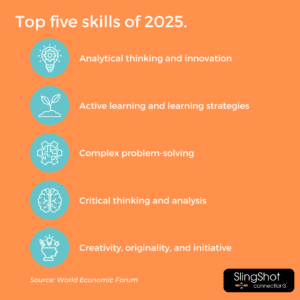
Worker expectations are changing
As the newer generation gets involved in the workplace, expectations among workers always start to change. But combine that with the Covid-19 pandemic and you’re left with a complete shift in worker expectations. For one, remote work has increased in demand by workers who want more flexibility. But companies are beginning to shift to in-person work, leaving a divide between expectations.
Another is the change of attitude between long-term employment and loyalty. Millennials and younger generations are more likely to job hop or leave jobs they aren’t satisfied with compared to older generations where workers would stay with one company for most of their career. Companies will need to adjust to this changing attitude, especially when there’s such a shortage of talent. We’ll go into more detail on what these expectations are in the next section.
How to overcome it
With the right strategies, it’s possible to turn this challenge into an opportunity. Here are the different ways you can overcome the talent shortage. It’s important to take a step back and analyze where improvements need to be made in your company, some of these will apply to some more than others.
Upskill your employees
Instead of hiring new talent, invest in reskilling your current workforce. Current surveys show that Gen Z workers are more likely to look for opportunities to learn and practice new skills compared to other generations. Offering upskilling in the workplace could help your current employees and even attract new ones too.
Accenture breaks down the 3 components needed to transform upskilling in your workplace and narrow the skills gap.
Shift the focus from institutions to individuals
Before you create a plan for upskilling your employees, you first need to figure out what skills you want them to possess.
A lot of companies make the mistake of relying on institutions like education to establish what is expected in an industry. For example, the standard for a website designer is to know how to code, design, and create. And schools will do their best to teach these skills. But in the real world, companies no longer need a designer to just make a website. They may need them to be client-facing, or to learn how to fit the needs of the customer. Suddenly, the role requires the website designer to wear many different hats, some of which aren’t taught in school.
Going forward companies need to map out what skills they need from every individual at their company and be willing to train them.
Speed up experiential learning
The most effective way to learn something is with a hands-on, immersive approach. Think about how long it would take you to learn how to drive solely by watching YouTube videos. Now, compare it to sitting behind the wheel of an actual car and practicing. The same goes for learning a new job.
When reskilling, focus on active learning that makes the trainee a participant. This is where on-the-field training and apprenticeships are extremely effective.
Empower vulnerable learners
As you’re providing learning systems within your company, don’t overlook what are called vulnerable employees. These are employees who are at risk of being replaced by technological change. A warehouse who may lose his job because his employer invested in automation.
Try to think of what the next role would be for your vulnerable employees and think about how you can turn them into vulnerable learners. If given the chance, many of these employees would jump at the opportunity to learn a new skill and move up to a new position.
Improve retention efforts
Although upskilling does a great job at improving retention within a company, you’ll still want to focus on other aspects that keep employees happy and engaged with their place of work.
Figure out what your employees are unhappy about and what caused previous employees to leave the company. According to a 2021 survey by Pew Research, here are the top reasons employees left a job. Think about if any of these apply to your workplace and where you could offer more flexibility.
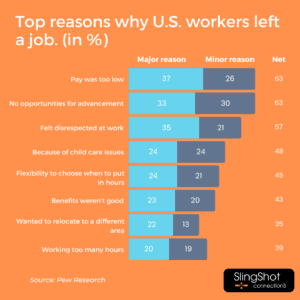
Improve your talent pipeline
If you still need to hire employees, you should do so by improving your talent pipeline. Pipelines are ways of creating pathways where potential employees are guided and nurtured. Having a pipeline means a company will get a steady flow of candidates applying for the job. This means knowing where to find employees, maximizing the amount of applications, and having strategies to keep them interested.
Internal referral program
The first thing every company should do to build a pipeline is to reward referrals from your own team. Offer some sort of commission for every referral that gets hired. According to ERIN, Referral hires are 40% more likely to be retained after one year than non-referral hires. Hiring costs are also typically lower for candidates hired through employee referrals.
Interact with past candidates
The second is to build and maintain a database of candidates who interact with your job postings. Even if a specific candidate isn’t the right fit at the moment, it doesn’t mean they can’t find a role there later.
With the database, you can reach out to candidates to keep them updated with updates about your company and keep in touch in case you have an opening for them.
An alternative solution: Hire an external workforce agency
If you need employees now, consider using a staffing agency.
Building a talent pipeline takes time, and it should. You don’t want to rush on something as important as this.
But as you’re building it, a staffing agency can fill the mold of what you have and use its talent pipeline to hire employees.
Here at Slingshot, we have a robust pipeline that allows us to pool quality employees from all kinds of different industries.
Want to learn more about how Slingshot can help solve your talent problems? Email us at clientservices@slingshotconnections.com for a free consultation where we can figure out your unique needs and how we can help.
Be the first to know about our newest staffing resources. From staffing trends to tips on improving your own staffing.
